Marc Bell, CEO of Terran Orbital, spoke to Air & Space Forces Magazine at the 2023 Air, Space & Cyber Conference on how responsive space is changing and how Terran Orbital is helping get space gear into the hands of the warfighter.


Marc Bell, CEO of Terran Orbital, spoke to Air & Space Forces Magazine at the 2023 Air, Space & Cyber Conference on how responsive space is changing and how Terran Orbital is helping get space gear into the hands of the warfighter.
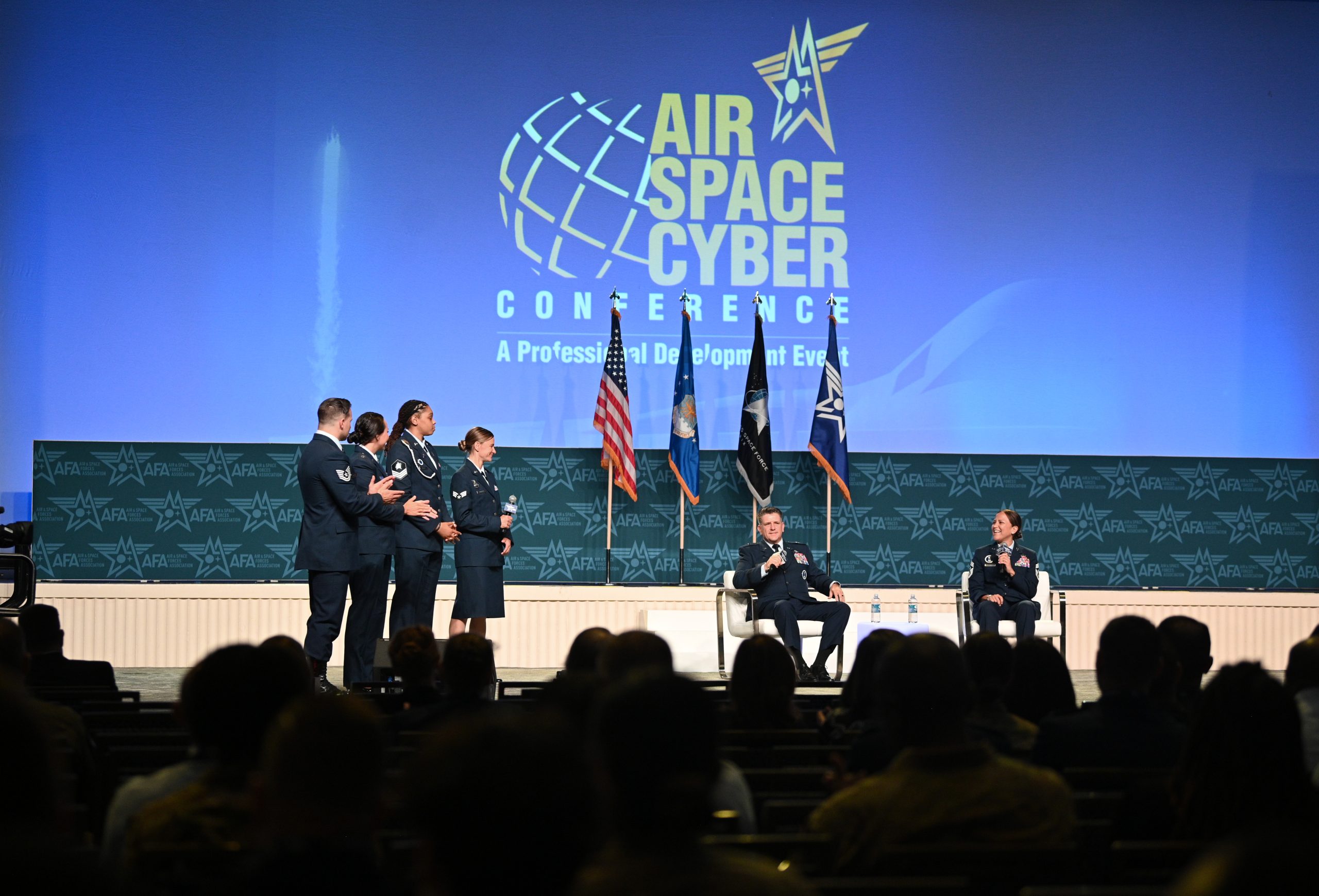
Amid military-wide recruiting struggles and bleak long-term trends, the Air Force is set to miss its annual recruiting goal for the Active-Duty component by around 10 percent when the fiscal year ends Sept. 30, with slightly worse numbers for the Guard and Reserve, officials said Sept. 11.
Seeking to close the gap, the Air Force Recruiting Service is looking outside its traditional workforce of recruiters to retired members and everyday Airmen and Guardians, AFRS boss Brig. Gen. Christopher Amrhein and others said at AFA’s Air, Space & Cyber conference.
The Air Force first started projecting a 10 percent recruiting shortfall in March, and the service subsequently implemented changes to relax restrictions on tattoos, naturalization, and body mass index, part of a broader effort to “make sure we’re not unintentionally placing barriers [in front of] Americans who might want to join our formation,” Vice Chief of Staff Gen. David W. Allvin previously told Air & Space Forces Magazine.
Yet there are broader cultural issues that make talent acquisition difficult, Amrhein said. Fewer youth today have parents with military connections, and results a generational gap in military knowledge and experience passed down within families:
“In 1995, about 40 percent of parents were either serving or had served in the military,” Amrhein said. “But in the last couple of years, it’s been only around 13 percent inside households.”
Amrhein also noted a recent study on parents’ and grandparents’ support for their children or grandchildren joining the military. According to the study, around 50 percent of grandparents and fathers favored the idea, while only about 36 percent of mothers said they would support their children joining the service.
“That’s where we come in. People aren’t recommending the service as much as they used to for various reasons,” said Chief Master Sgt. Rebecca A. C. Arbona, Command Chief Master Sergeant of AFRS.
Another factor exacerbating the gap between the military and the community is the shortage of recruitment distribution due to the increasing cost of talent acquisition. As an example, Amrhein pointed out that there are only four Air Force recruiters in the state of Montana.
To address these issues, Amrhein said AFRS has introduced E-recruiters—retired Air Force recruiters who stay engaged with the community through virtual platforms. They effectively cover regions that regular recruiters cannot reach.
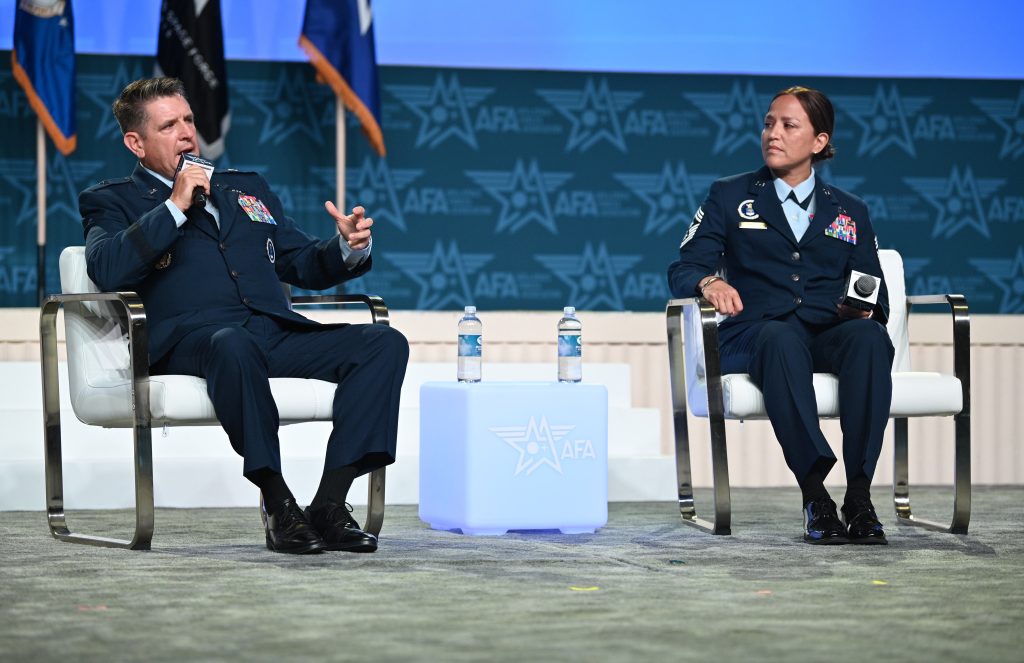
Amrhein also noted the partnership with AFA and AFA’s recruiting task force and their role in expanding recruitment, adding that he’d like to have a document outlining tactics, techniques, and procedures that he can distribute to chapters nationwide
More broadly, Amrhein urged Air Force and Space Force personnel to share their personal journeys. He emphasized the importance of Active-Duty and retired service members, along with their families, telling their stories to inspire the next generation.
“What was your ‘why’? Why did you join the Air Force, and what do you do every day?” he asked. “It’s important. Tell your story. You are an influencer just as much as you are a recruiter, for every Airman and Guardian.”
To illustrate the diverse motivations behind Airmen’s decisions to join the service, four members from the audience took the stage. Tech. Sgt. Cam Kelsh said his decision to enlist was deeply influenced by the shock of witnessing the Sept. 11, 2001 attacks on the news alongside his mother when he was only in sixth grade. It was at that moment, he said, he realized that his homeland was not invulnerable.
Senior Airman Kristina Schneider said she had a lifelong desire to be part of the Air Force. However, she initially believed it was an impossible dream due to starting her family at a young age. As her children grew older, she mustered the courage to ask them if they were comfortable with her pursuing her dreams. To her surprise, they encouraged her to go for it, and she was able to join the Air Force before reaching the age limit for enlistment.
Amrhein stressed how these unique, individual experiences of all members of Air Force and Space Force could have an impact on the community. And he encouraged everyone to take a more active role in staying connected and sharing information, while highlighting the crucial role of social media, especially to engage with Generation Z.
Amrhein assumed command of AFRS on June 2, acknowledging that he was taking over “in a challenging time.”
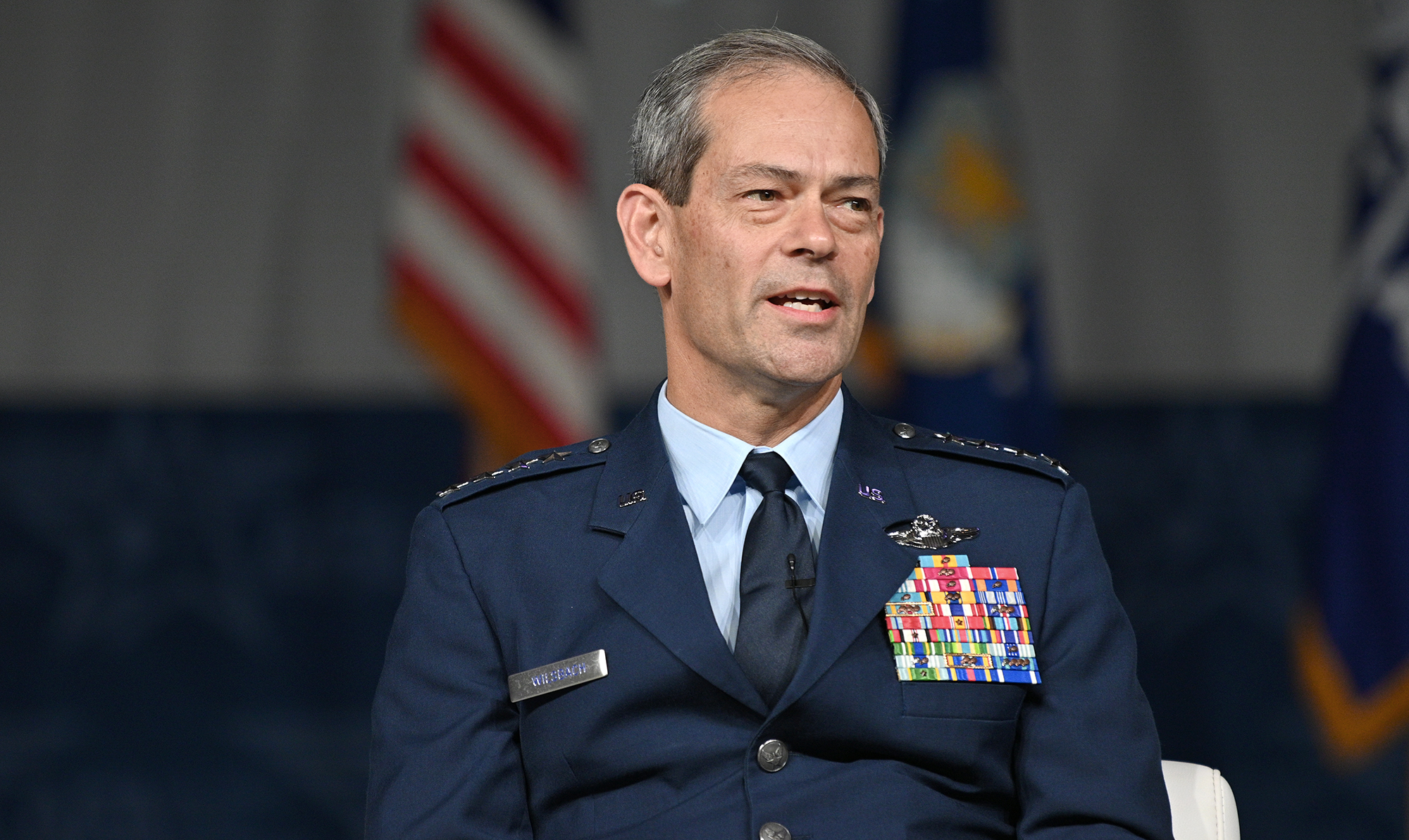
Chinese pilots are risking “disaster” with repeated unsafe intercepts of American planes operating in the Pacific, the top U.S. Air Force general in the region said Sept. 11.
“We do fly a lot close to China,” Gen. Kenneth S. Wilsbach, commander of Pacific Air Forces, told reporters at AFA’s Air, Space, & Cyber Conference. “It’s not uncommon for U.S. military aircraft to be intercepted 10 times a day.”
For the most part, the intercepts—which the U.S. military stresses occur in international airspace—are “safe,” Wilsbach said.
Sometimes, however, there are incidents the Pentagon deems risky. The U.S. and many of its allies have taken to publicly identifying some of these incidents, seemingly trying to shame the People’s Liberation Army for operating their aircraft and vessels recklessly. China has a different view.
“When we call them out on these unprofessional, unsafe [intercepts], they’re not willing to have a discussion,” Wilsbach said. “We don’t have that kind of conversation. They blame it on us.”
China claims most of the South China Sea, over which American surveillance aircraft such as USAF RC-135s routinely fly, as its territory.
“Their typical response is, ‘This is your fault because this wouldn’t have happened if you weren’t here,’” Wilsbach said. “Now, let’s just get to the gist of the problem, which is what they’re saying is they don’t want us to exercise the same right that they have to be in international airspace.”
Wilsbach said the U.S. does not take issue with the broad premise of its aircraft possibly being intercepted. NORAD aircraft often intercept Russian aircraft in the Alaska Air Defense Identification Zone (ADIZ), an early warning buffer that extends beyond U.S. airspace. The U.S. military typically stresses those incidents do not violate American sovereignty.
“All we’re asking them to do is just execute safely and professionally,” Wilsbach said. “You can intercept. That’s your right to intercept, just like we do when we have aircraft flying inside of our air identification zones. So do it safely, do it professionally, and everybody will be OK. We won’t have a miscalculation. We won’t have a disaster.”
Wilsbach, speaking broadly about Chinese pilots’ capabilities, said he “wouldn’t think that any of them have prowess like an American fighter pilot,” though he did not cite Chinese aviators’ skills as a safety concern.
“They are not in the same category as what we are trained to,” Wilsbach added.
The U.S. is particularly concerned about the actions of Chinese aircraft because of a lack of high-level communication between the two sides. Military-to-military channels have largely been frozen since Secretary of Defense Lloyd J. Austin III met his then-counterpart last November.
Since that meeting, tensions in the region have only grown between the U.S. and China. A Chinese jet came within a few yards of U.S. Air Force RC-135 over the South China Sea in December, and in February, an F-22 Raptor shot down a Chinese surveillance balloon that transited the continental U.S. U.S. officials have stressed they want communication to avoid escalation.
“It’s really important that the most senior folks can talk to each other as quickly as possible when something happens,” said Dr. Mara Karlin, who is performing the duties of deputy undersecretary of defense for policy, at a Defense Writers Group Event in August. “So Secretary Austin keeps asking for that.”
The often opaque nature of decision-making by the Chinese Communist Party and its People’s Liberation Army under leader Xi Jinping makes it difficult for the U.S. to judge intentions without interactions, experts note.
“We have been trying really hard to set up communication channels and they have not been enthusiastic about those,” Karlin added. “That’s really problematic.”
China insists U.S. sanctions prevent a meeting between Chinese Defense Minister Li Shangfu and Austin, though U.S. leaders say that is not the case. China’s Defense Ministry also insists military-to-military talks have “not stopped.”
In a meeting that occurred after Karlin’s comments, the head of U.S. Indo-Pacific Command Adm. John Aquilino spoke to Chinese military officials at a defense forum in Fiji last month. But overall, substantive talks remain limited.
A previous encounter between U.S. and Chinese aircraft turned deadly and led to a diplomatic crisis. A Chinese fighter and a U.S. Navy EP-3 reconnaissance plane collided in 2001, resulting in the temporary detention of U.S. personnel after they were forced to make an emergency landing in China. The Chinese pilot was killed.
China’s unwillingness to engage in substantive talks or establish lines for discussion in a crisis, in particular, creates concern for regional commanders like Wilsbach when incidents occur.
“That’s concerning to me because some of these could be very close to a disaster,” Wilsbach said.
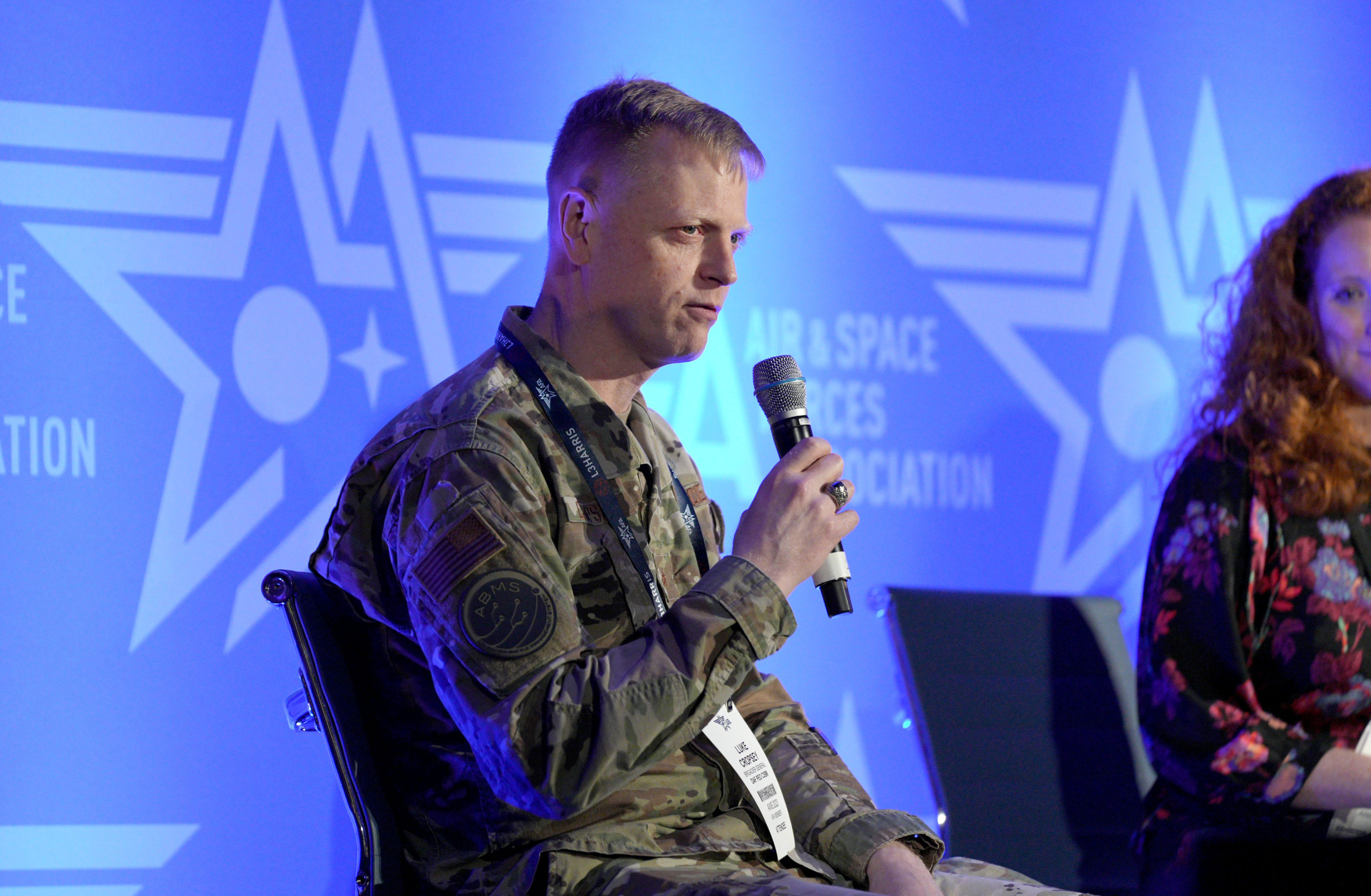
After years of planning, experiments, and discussion, the Department of the Air Force is ready to start modernizing its command, control, and communications capabilities now, the top general overseeing the effort said Sept. 11.
“The modernization of [C3] isn’t tomorrow, it’s today,” Brig. Gen. Luke C.G. Cropsey, integrating program executive officer for command, control, communications, and battle networks, told reporters at AFA’s Air, Space & Cyber Conference. “We’re deploying capability starting now. It will obviously continue to happen in the future. But this isn’t something that’s five years away. This is today. So we’re putting capability out in the field.”
Cropsey’s declaration comes two years after Air Force Secretary Frank Kendall first expressed concern that the Advanced Battle Management System, the department’s ambitious plan to connect sensors and shooters across the globe, was not focused enough on deploying operationally relevant capabilities.
Specifically, Cropsey said his team is prepared to declare initial operational capability for its Could-Based Command and Control (CBC2) network for U.S. Northern Command and North American Aerospace Defense Command next month. CBC2 will aggregate and integrate military and commercial air defense data sources into one common picture to support homeland defense.
Cropsey also said that before the end of the year, the Air Force will start fielding a new digital infrastructure needed to support new system architectures his team has been helping to develop for months.
CBC2 was previously called Capability Release 2, intended to be the second deliverable product of ABMS. In the works starting in 2021, the system officially became a program in May 2022.
According to an Air Force release, CBC2 fuses data from 750 radar feeds into a single interface and allows operators to create “machine-generated courses of action to help shorten the tactical C2 kill chain and send a desired effect via machine-to-machine connections.”
The system is replacing the Battle Control System-Fixed network and integrating data from other air and missile warning and missile defense systems. But rather than attempting to build one massive capability, Cropsey said his team chose to “thin slice” it.
“We didn’t do an overall CBC2 contract and hand it off to somebody that kind of did all the typical integration kinds of things,” Cropsey said. “We actually went directly to the experts in their respective layer of the stack, and we said, ‘Hey, who’s the best at ‘fill in the blank’ and we went and we got them on contract.”
One of the biggest contracts went to SAIC, which got $112 million as the software integrator for the system, “but we’ve got a lot of contracts all operating together on that CBC2 piece,” Cropsey noted.
The Air Force has referred to the various capabilities from those contracts as “microservice applications,” with an emphasis on regularly releasing updates.
That process, called agile development, security, and operations or DevSecOps in the software world, is one the Pentagon writ large has struggled to adopt, but Cropsey said his team and U.S. Northern Command are dedicated to making it work.
“The [combatant command] ponied up to giving us operational people, so for every microservice that we’re generating inside of the CBC2 architecture, we have literally a dedicated operational person with that team that’s generating that microservice,” Cropsey said. “So we’re actually generating the kind of user and development cycle that an agile process actually calls for. That may be the single biggest reason why CBC2 is moving as well as it’s moving.”
Given that success, Cropsey said he’s already started thinking about how to scale and implement CBC2 in other combatant commands and regions of the world.
For much of fiscal 2023, Cropsey said, his office has worked on the architectures necessary to enable modernized command and control—the connections and organizations needed for the Air Force’s ambitious plan to connect sensors and shooters around the globe. Leading that effort has been Dr. Bryan Tipton, C3BM chief of architecture and engineering.
In recent months, Tipton and his team have delivered analyses to the Secretary of the Air Force on the architectures needed in air and space for modernized C2. The contents of those analyses are classified, Cropsey said, but a key underlying element is the digital infrastructure—the computing power, programs, and process necessary to make the architecture work.
“Regardless of where you’re going to fight, what you want to communicate, the data and the information that you need to flow through that system, if you don’t have a digital infrastructure to do it on, it’s a pipe dream,” Cropsey said.
The Air Force’s IT systems and computing power are often a source of frustration for the average Airman, but Cropsey projected optimism that the “DAF Battle Network” will have what it needs.
“We’re going to start putting digital infrastructure out into the field this year,” said Cropsey. “So, super excited about that. It’s fundamentally an enabler of anything that you want to actually do from a C2 perspective.”
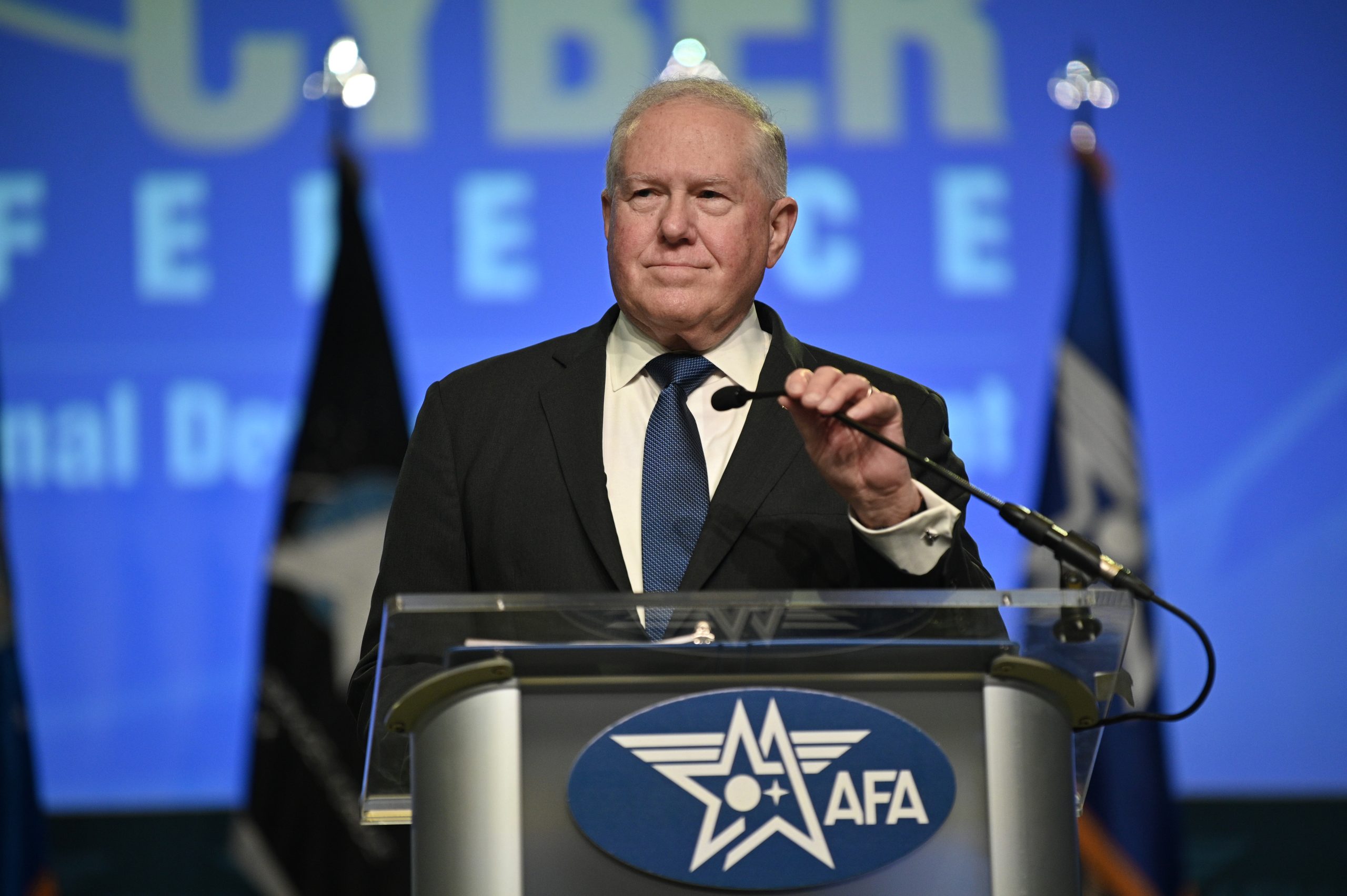
With the threat of a government shutdown looming, Secretary of the Air Force Frank Kendall issued an urgent plea to Congress at AFA’s Air, Space, & Cyber Conference on Sept. 11.
“We have already lost far too much time waiting for Congress to act on our modernization funding needs,” Kendall said during a keynote address.
In his speech, Kendall outlined three major asks from lawmakers:
“We urge you to give us the authorization, appropriations, and confirmations that it is your duty to provide for our military,” Kendall said in remarks directed at lawmakers.
The Department of the Air Force has sweeping plans for a whole host of modernization programs like Collaborative Combat Aircraft, Next Generation Air Dominance, and the LGM-35 Sentinel intercontinental ballistic missile. But Congress is deadlocked in budget negotiations, with the end of the fiscal year looming at the end of September.
Already, Kendall noted, the chances of getting a fiscal 2024 budget on time are all but finished. Instead, he argued Congress must work to mitigate the damage.
“Waiting does not make us more competitive or enhance deterrence,” Kendall said.
In what has become common practice in Washington, if a budget is not agreed to by the start of the fiscal year, lawmakers can a “continuing resolution” to avert a government shutdown. But CRs only fund the government at current levels and halt “new starts”—projects or activities that were not previously funded or authorized. Collaborative Combat Aircraft would be perhaps the most high-profile Air Force new start in 2024.
“Do not extend any CR beyond December,” Kendall said. “We can manage a short CR as we have many times. Beyond that, much more serious damage would be done to American security.”
As Kendall noted, starting the year under a CR has become commonplace. But he pressed further in urging Congress not to enact blanket cuts to the military or allow a repeat of 2013, when lawmakers triggered automatic, large cuts—known as budget sequestration—across the U.S. government after failing to resolve a spat over funding levels.
“We endured this kind of irrational cut 10 years ago and are still recovering,” Kendall said. “We never want to do something like that again.”
Such a move would have “severe reductions in modernization and readiness,” he added.
A prolonged continuing resolution and budget cuts could go hand in hand—as part of their deal earlier this summer to raise the debt ceiling, the White House and Congress agreed to a provision that states that if any part of the government is funded by a CR starting Jan. 1, there will be a 1 percent cut for all discretionary spending until a new budget is approved.
Beyond his concerns for fiscal 2024, Kendall also reiterated his top legislative proposal for Congress—granting authority to the Air Force and the other military departments to start critical programs without a budget, what he termed a “quick start” proposal.
That would allow the Air Force and Space Force to begin “our highest priority and most urgent programs immediately without having to wait for even a regular budget cycle—to say nothing of a CR,” Kendall said. “This initiative will prevent us from losing ground unnecessarily in the military technological race with China.”
While Kendall is famous for defining his top three priorities as “China, China, China,” he insisted those words and other slogans aimed at modernizing were not bluster.
“For those of you who may be wondering when we’ll get back to normal, this is normal,” Kendall said of the U.S. competition with China. “We have a well-resourced strategic pacing challenge that is showing no sign of slowing down or quitting. We are in a race for technological and operational superiority that we can expect to last for the next several decades.”
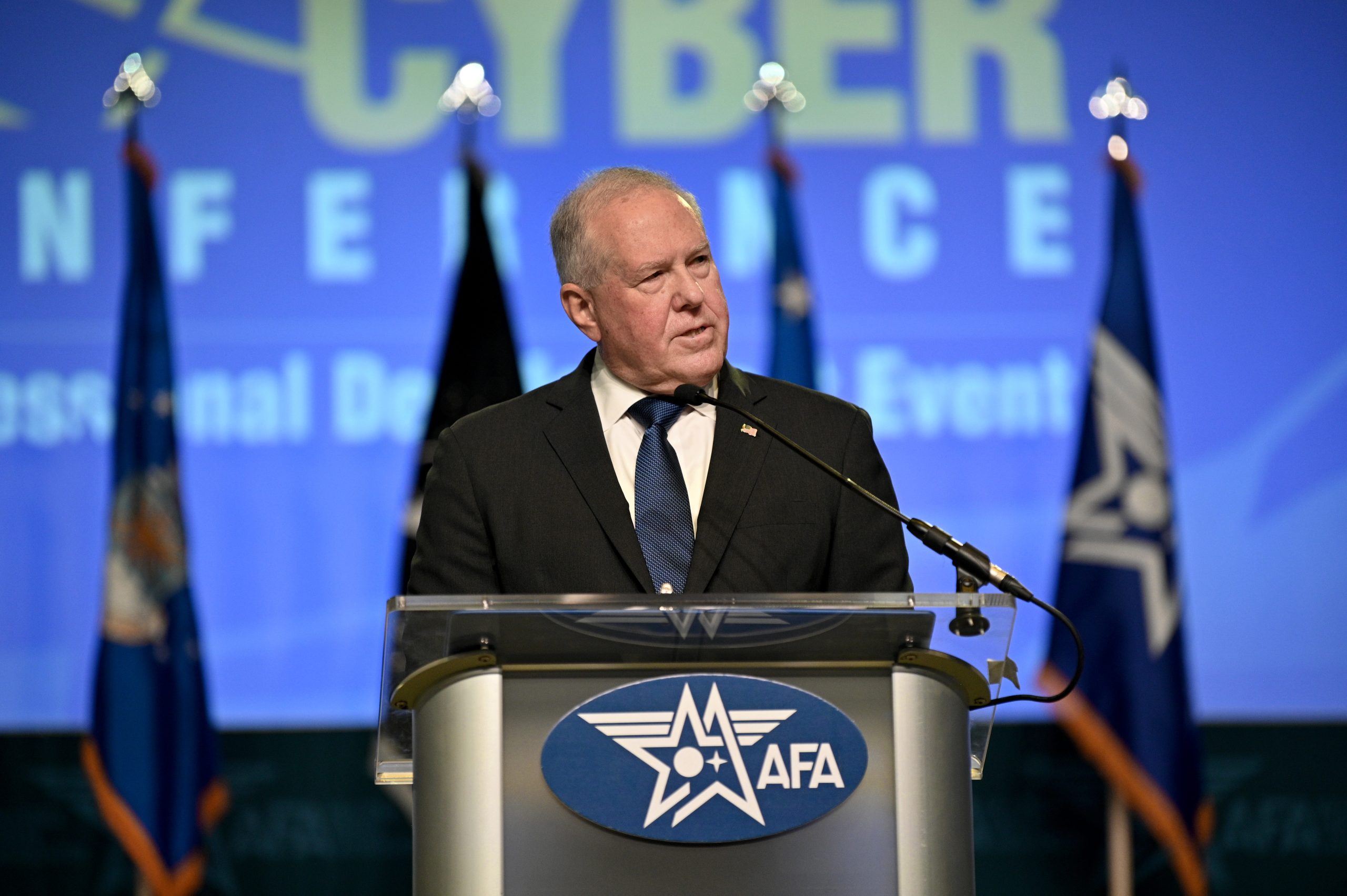
The sweeping review of Air Force readiness that Secretary Frank Kendall announced last week will pursue five lines of effort, he said in his keynote address at AFA’s Air, Space and Cyber conference on Sept. 11.
“There is no time to lose,” Kendall said of the assessment, which will be conducted, reviewed, and ready for implementation by January 2024. At that time, “that major effort will shift from identification” of areas needing improvement “and analysis of alternatives to execution of recommendations,” Kendall said.
The review is meant to “reoptimize” the Air Force for an era of great power competition with the likes of China and Russia, Kendall said. After launching his seven operational imperatives in March 2022 to modernize the platforms and the equipment the department needs for that competition, Kendall said he and his leadership team “are not as comfortable with other aspects of our enterprise.”
Specifically, the review and reorganization will focus on five lines of effort, led by “five teams formed from the Department of the Air Force Secretariat, the Air Force and Space Force staffs” with participation from the field, Kendall said. The five lines are:
“All these efforts will be closely guided by the Department’s senior leaders,” Kendall said. “It will be an inclusive process, open to and encouraging of innovative thinking. Just as we have challenging and innovative potential adversaries, we must be open to new ways of organizing and doing business ourselves.”
Kendall said that it is his goal that by the time of the next AFA national conference—in September 2024—“the changes we need to reoptimize for great power competition and possible conflict will be underway.”
He did not specify when he expects the reorganization to be complete but emphasized that time is of the essence, and the nation’s competitors are not relaxing their push to modernize and organize for future combat.
“It has become increasingly clear that more change is needed and that we need to accelerate this process,” Kendall said. “We must ensure that the Air Force and Space Force are optimized to provide integrated deterrence, support campaigning, and ensure enduring advantage.”
Kendall noted that some major changes are already underway, pointing to the Air Force Force Generation model (AFFORGEN), and “evolving allocations of responsibility across Space Force field commands.”
He also said that he created three Air Task Forces on Sept. 8 “to serve as pilots in order to experiment with ways to more effectively provide deployable integrated units.” Two of these will be tied to U.S. Central Command and one to U.S. Indo-Pacific Command.
“These are not the final, permanent deployable units we expect to form, but they are a major step in the right direction, and we will learn from this experience,” Kendall said.
The Air Force is also deep in the process of deploying its Agile Combat Employment model for dispersing forces across a wide array of operating locations, and is developing its “Multi-Capable Airman” concept, Kendall said, although neither is yet “fully implemented.”
Kendall noted that China has been reorganizing its armed forces since 2016, across exactly the same five lines of effort he laid out.
“Last week we briefed some of our outside advisers on this effort. One of them was born in China and is a leading expert on Chinese culture, history, and government. Her reaction was interesting; her view is that the DAF five lines of effort—organizing, equipping, personnel, readiness, and support—are essentially identical to the lines of effort [President] Xi Jinping has been implementing since 2016 to prepare China for war with the United States,” Kendall said. He repeated that the Air and Space Forces must not delay in optimizing for battle, the better to deter a conflict that the U.S. does not seek.
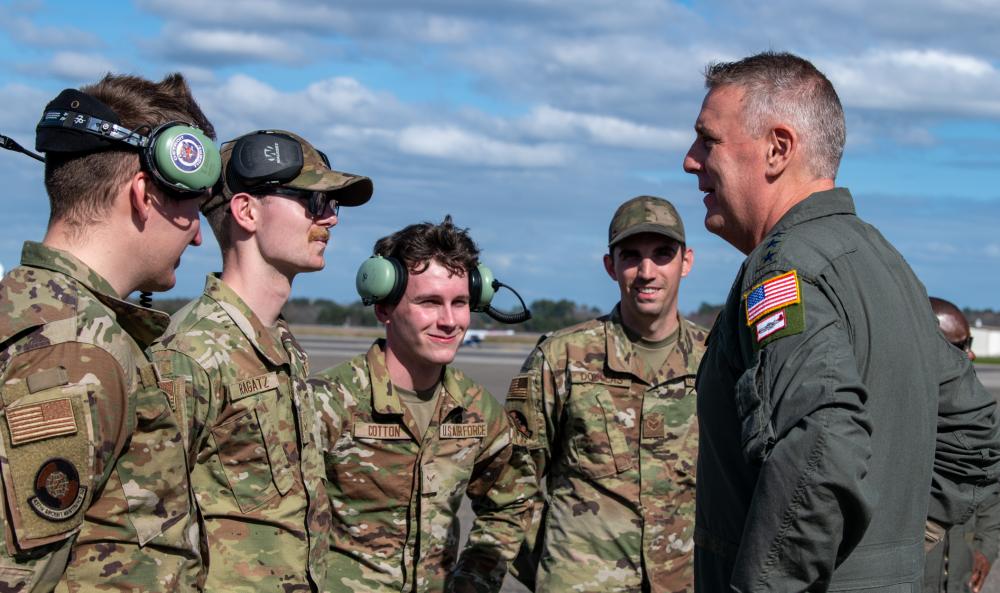
In July, Air Mobility Command wrapped up Mobility Guardian 2023, a massive exercise where 70 aircraft, 3,000 personnel, and several international partners practiced moving troops and supplies across the Pacific for two weeks.
After the exercise, AMC boss Gen. Mike Minihan identified three areas for improvement:
A college football aficionado, Minihan compared himself to a coach “coming off of a win, but a win that didn’t have the magnitude that it was supposed to have,” he told Air & Space Forces Magazine in a recent interview. “So the coach is mad. Not mad in an angry way, but mad in a ‘we can do better’ way. I could not be more pleased with the effort, but we’ve got work to do here.”
Particularly for exploding into theater, Minihan noted that over the past 20 years, Airmen typically had months to prepare for deployments to the Middle East, where they took familiar routes to the desert and had robust support along the way. Mobility Guardian 2023 was meant to provide the opposite experience.
“It was intentionally set up so that we didn’t have all those comforts, that our explosion was done very quickly,” Minihan said. “The en route support was what it was. We didn’t set it up to be successful, we did not set it up to be a challenge, we just let the real world be the real world. And it proved itself to be a handful.”
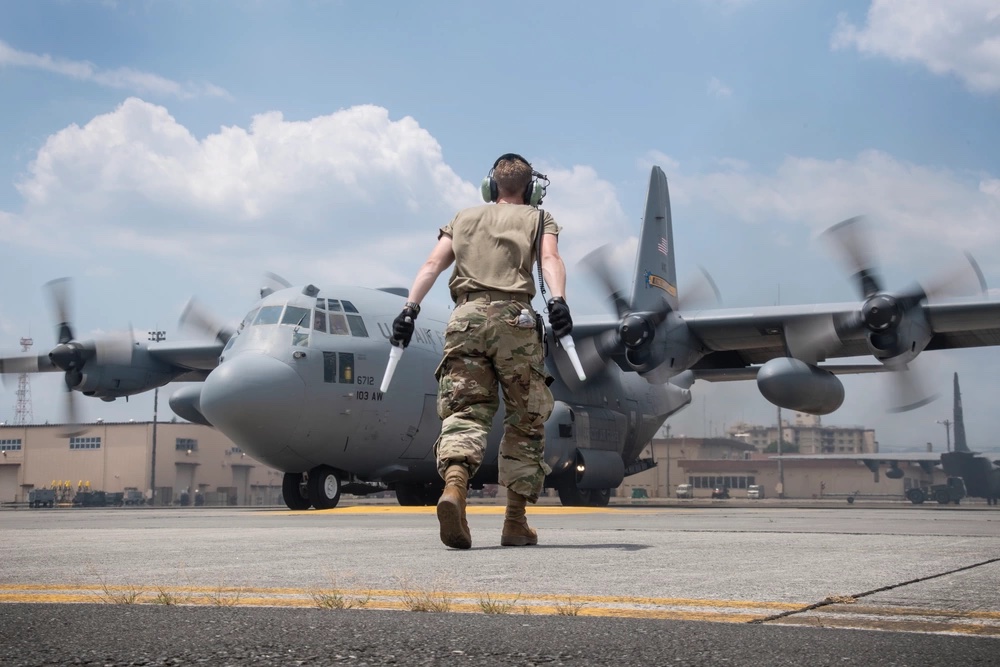
Minihan said he wants his troops to “understand the urgency for which they need to get into theater, get into the employ phase and that they just won’t be denied that rapid entry.” Cultivating that attitude will take practice in the form of austere exercises, but Minihan said most of the burden for improving the ‘explosion’ falls on him and his headquarters.
“The first mirror check is with me, to make sure that this headquarters is doing everything possible to organize, train, and equip our Airmen for success,” he said. “Have we given everything to our Airmen that they need? Have I given them enough guidance that has depth to it?”
Mobility Airmen already supply troops, respond to natural disasters, refuel aircraft, conduct rescue missions, fight wildfires, and much more. When asked how Airmen are supposed to juggle these responsibilities and practice new war-fighting skills, Minihan was empathetic.
“When you talk about the multiple competing priorities of very important missions as presented by all the combatant commands, both functional and geographic, for a team that’s got 110,000 folks total force and we fly a little over 1,000 airplanes, that’s going to be a handful,” he said.
There will never be enough time, people, and money to meet the burden, which means the command must “invest our intellect” to be successful, Minihan said.
“That’s the responsibility I have,” he said. “I have to create the time and the priority for the team to be ready. I have to understand the ops tempo so that there’s not burnout. I have to create an atmosphere where they can get after the priorities that they need to be successful.”
Part of the purpose of Mobility Guardian was to see how responding to a conflict would go amid Air Mobility Command’s many other duties, duties that are not going away anytime soon. Meanwhile, the general’s advice for how Airmen can be ready to ‘explode’ was simple: ask him for more.
“Be demanding of me, be demanding of me and the team up here,” Minihan said. “We have to make sure that we’re working as hard as the Airmen are on all of these things.”
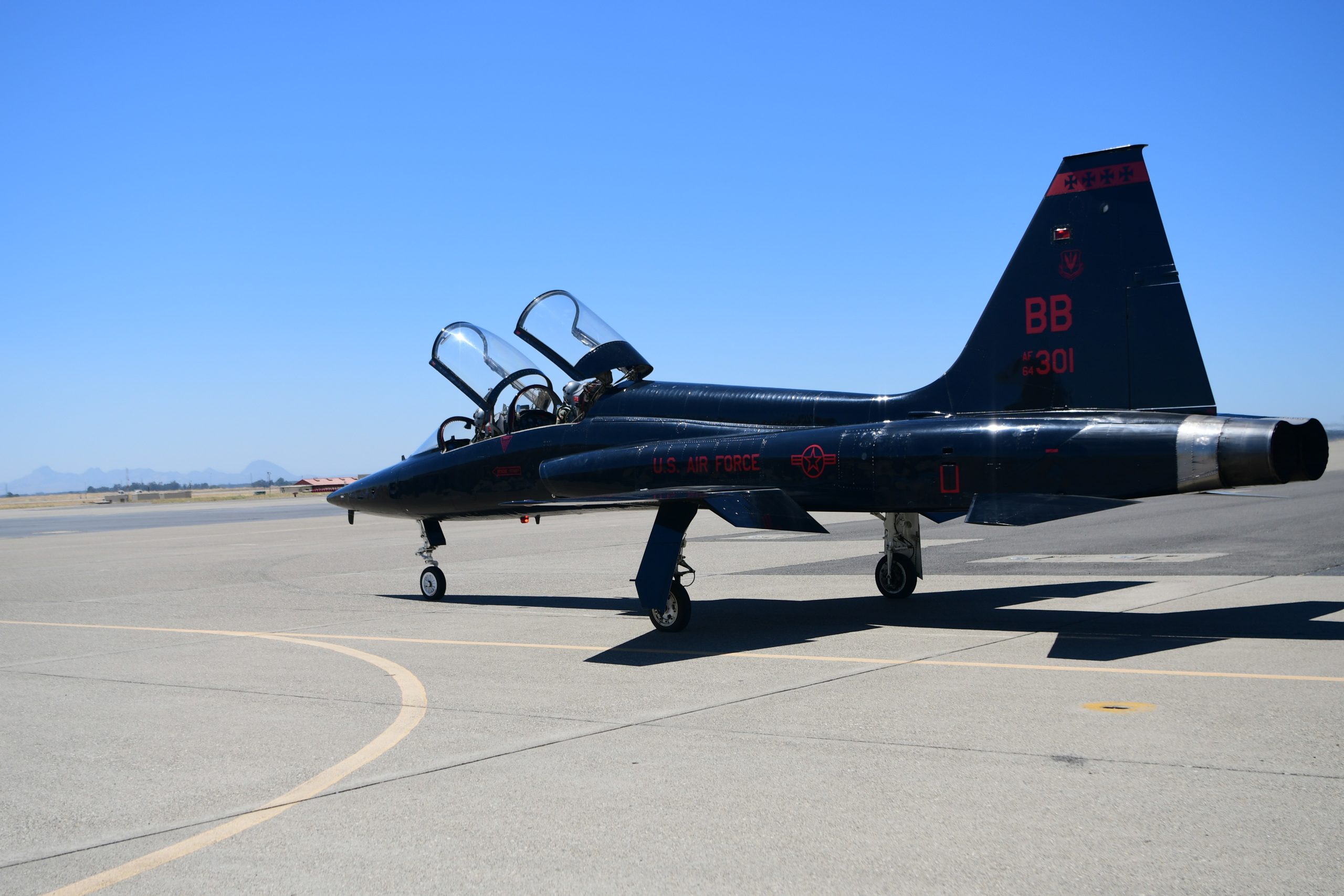
While some future Air Force pilots wait for cockpits to open up so they can start training, they’re doing everything from public affairs to marshaling aircraft on the flight line, the head of the 19th Air Force said recently—highlighting the persistent problems the service faces in trying to reduce its pilot shortage.
As of Aug. 25, more than 900 Airmen are waiting to enter the pilot training pipeline, according to 19th Air Force data. Roughly a quarter have been waiting less than three months, but most are between three and nine months. Another quarter—around 220 people—have been stuck even longer.
“Wings will have these lieutenants that are waiting pilot training work in their PA shop,” Maj. Gen. Clark Quinn said during a briefing with reporters. “They will have them work in their command post, doing reporting. They will actually take some of them and teach them how to not necessarily do aircraft maintenance, but put them out on the flight line and marshal aircraft in and park, and get them connected to the mission. So they are kept gainfully employed unless they choose to take some leave and obviously take some time off.”
A spokesperson later added that future pilots also knock out their survival training while they wait. Some are assigned to earn postgraduate degrees.
The total number of those waiting is down slightly from a peak of more than 1,000, Quinn said. The Air Force is limited in part by the availability of its training aircraft, all of which entered service at least two decades ago.
The T-38 Talon, in particular, used to train future fighter and bomber pilots, is “frankly, struggling,” Quinn said. Production of the T-38 ended in 1972.
“The mission capable rates of the T-38 are not good,” Quinn added, noting that engine problems have forced the 19th Air Force to limit flying hours—and, in turn, prevented it from reaching its goal of producing 1,500 pilots per year.
The T-38 is not alone in experiencing issues, however. A batch of T-6 Texan IIs were damaged in a recent storm at Vance Air Force Base, Okla., Quinn said. And the service is in the process of retiring the T-1 Jayhawk, with aircraft already heading to the Boneyard at Davis-Monthan Air Force Base, Ariz.
Long term, the Air Force plans to replace the T-38 with the T-7 Red Hawk, an advanced new trainer currently undergoing flight testing. However, the Red Hawk has been delayed several times through development and is now not expected to reach initial operational capability until 2027.
There’s nothing Quinn can do to speed up the T-7’s schedule, but he said gaining it in the fleet will not only increase availability but also improve the overall training pipeline.
“[The T-38] a 60-plus-year old design that was designed for a type of aircraft that we haven’t flown in 30 years, and we spend a lot of time in training teaching young aviators how to do things that they don’t need in their next aircraft,” Quinn said.
In fiscal 2022, the Air Force produced 1,276 pilots. In 2023, that number increased slightly to around 1,350, but still short of the goal of 1,470. With demand from commercial airlines strong, the need for new pilots to replace those leaving the service is persistent. The 19th Air Force’s goal will be 1,500 new pilots in fiscal 2024, a spokesperson said.
Quinn said the overall pilot shortage remains at around 2,000, roughly the number it has been for the last several years. Vice Chief of Staff Gen. David W. Allvin previously told Congress that the Air Force has taken steps to ensure the shortfall doesn’t mean aircraft aren’t flying.
“In order to have a healthy pilot professional force, you need first and foremost the combat cockpits filled,” Allvin said in April. “Then you need the trainer cockpits filled. Then you need the test cockpits filled. And after you fill out the cockpits, then our next priority is the leadership—you want the leadership positions filled. And then after you have all those filled, then you go to the staff positions. That is where we are currently absorbing our shortage: in the staffs.”
Echoing Allvin, Quinn said that not filling staff positions has a long-term effect by stunting the “mentoring and growth of the officers that we expect to be able to lead our Air Force in the future.”
Pilots aren’t the only staffing shortfall—even the civilian flight instructors who teach future pilots on simulators are undermanned, Quinn said.
“We have openings at all of our locations. In some cases manning is down at the 60 to 70 percent level,” Quinn said. “What we ended up having to do is take military instructors to fill those civilian gaps and teach them and when you’re teaching the sims, you’re not teaching the flights.”
To address that problem, the 19th Air Force is trying to hire remote simulator instructors to entice civilians who don’t live near Air Force training centers. At the moment, though, Quinn’s team is working on a latency issue affecting that effort.
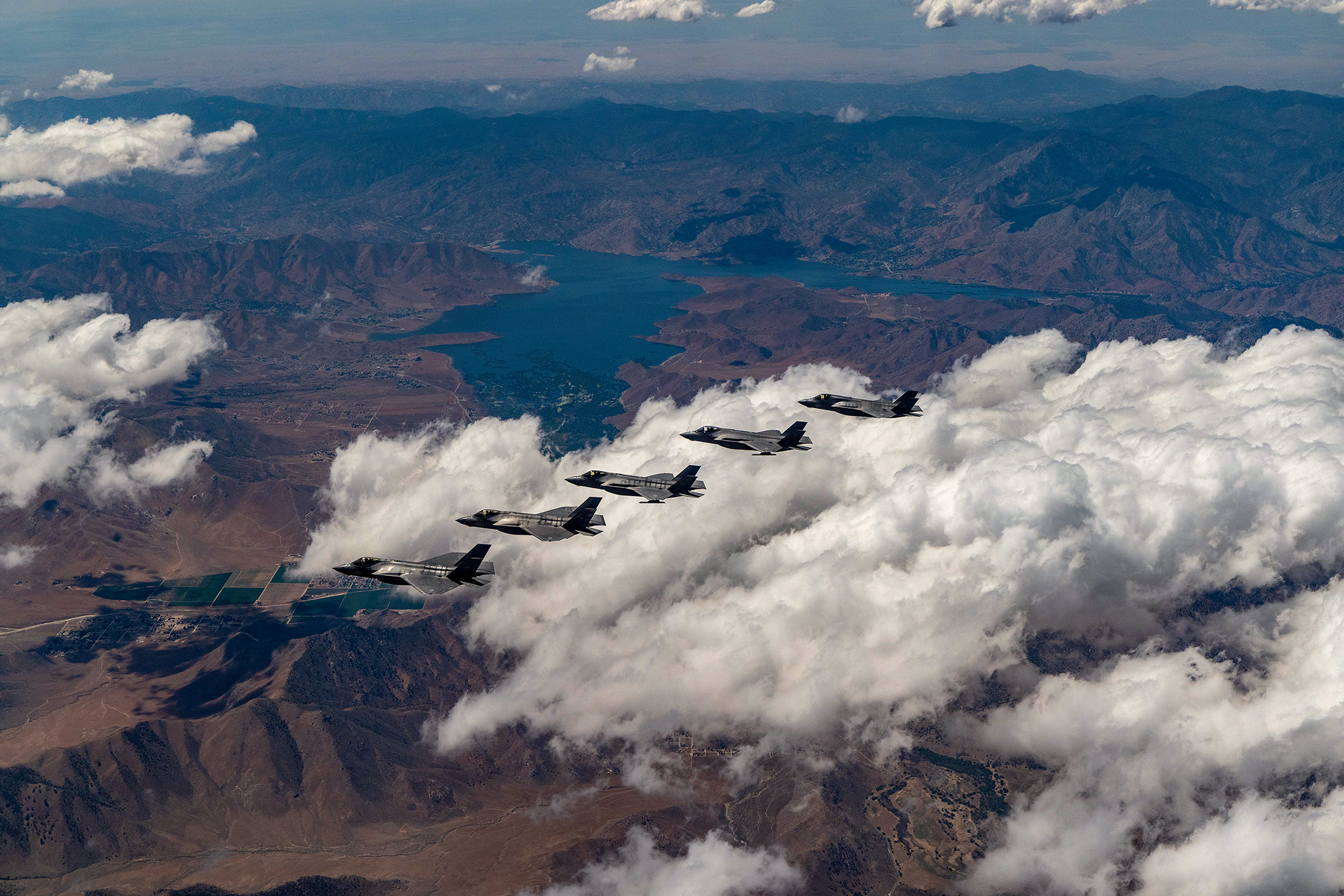
The Tech Refresh-3 update of the F-35 fighter may face more delays due to insufficient manpower and test resources and suffers from an unrealistic degree of concurrency, the Joint Program Office director told Air & Space Forces Magazine in an exclusive interview.
What’s more, there was no backup plan in case the TR-3, needed for the much-anticipated Block 4 upgrade, did not deliver on time, said Air Force Lt. Gen. Michael J. Schmidt.
Now “here we are,” more than two years late in delivering the capability, he said Sept. 8.
“I still see risk in front of us,” Schmidt added of the TR-3 update. Although testing of the TR-3 is well underway, the first F-35s built with the new system won’t start reaching the fleet until next year. Schmidt took over the F-35 program in August 2022.
Lockheed Martin, the prime contractor on the F-35, announced last week the first TR-3-equipped jets won’t be delivered until between April and June 2024, after previously saying they would arrive by the end of 2023.
“As a result, we now expect to deliver 97 aircraft in 2023, all in the TR-2 configuration,” the company announced. “We are continuing aircraft production at a rate of 156 per year while simultaneously working to finalize TR-3 software development and testing.”
Schmidt echoed Lockheed in saying the Joint Program Office’s timeline is now April to June. The delays stem from hardware arriving late, software behind schedule, and a late start to flight testing, he said. There are also not enough people working on the program, he added.
The TR-3 update replaces the computational core of the F-35 with a much more powerful processor, which will run the Block 4’s more powerful electronic warfare suite and accommodate a greater number of weapons and classified capabilities. The Air Force has held down the number of F-35s it’s bought in recent years, saying it prefers to wait for the more powerful Block 4 version.
There was an “extremely optimistic” plan for shifting from the TR-2 to TR-3 versions, Schmidt said, with “a lot of assumptions about improvements in time that would be made that did not come to fruition.”
“Block 4 by itself is 80 or so different capabilities. … And we have a plan to put them into various lots, but in my opinion, that plan wasn’t informed by true technical decision-making at critical junctures that said, ‘no kidding, we can get it into this lot,’” Schmidt said. The TR-3 is supposed to go into F-35s built in Lot 15.
Schmidt added that “there’s a lot of concurrency in this program, which is fine. Concurrency … is good, in a lot of cases.”
However, “you need to look at what is the probability” of implementing an update according to schedule, he said, as well as “the consequences of it not being ready on time.” Integrating a new weapon is one thing, while a fleetwide hardware and software change is another.
“We did not have a backup plan with the old hardware,” he said. “We made a decision a number of years ago that we were going to go all-in, and, in my opinion,” given the magnitude of the upgrade, perhaps should not have “made the decision to implement this in Lot 15, or we would have at least had a backup plan before going forward with it. And so here we are … late to need on TR-3.”
While “the hardware is doing pretty well right now, the software integration started late. And so that was a challenge,” he said.
Much of the problem has to do with resources, Schmidt said.
“Our lab infrastructure is not what it needs to be,” he said. “The lab is not fully representative of the flight test environment, and the lab capacity is nowhere near what it needs to be.” Testing is still underway with the latest version of the TR-2 hardware and software, and that’s pulling lab time away from TR-3, he added.
“We’ve got the first version of software for TR-3 in the labs right now and then even the follow-on version of software for TR-3 is in the labs. And they’re literally having to switch the labs over from one to the other, which is a significant amount of time to try to work those things in parallel,” Schmidt said.
On top of that, “our flight test infrastructure is old; it is really old,” he asserted. “We are doing everything we can to limp it along. We have a lot of support from the U.S. and our partners to buy additional flight test airplanes. We should have bought or replaced those aircraft years ago, but here we are.”
There are three dedicated TR-3 test jets coming, Schmidt said, “that were appropriated a couple years ago,” and six more are needed to flesh out the TR-3 test fleet. It hasn’t been decided yet how they will be apportioned among the F-35A, B, and C types.
“We’re not talking about flight test aircraft, I’m talking about Flight Sciences aircraft,” Schmidt said. “So fully wired-up, test aircraft.” Some are targeted for software testing and others are needed for full weapons integration testing.
Then there’s a new Engine Core Upgrade coming, “hopefully, with the support of the Congress, and that will require flight test aircraft as well,” Schmidt said.
As a result, the availability of test aircraft is a limiting factor.
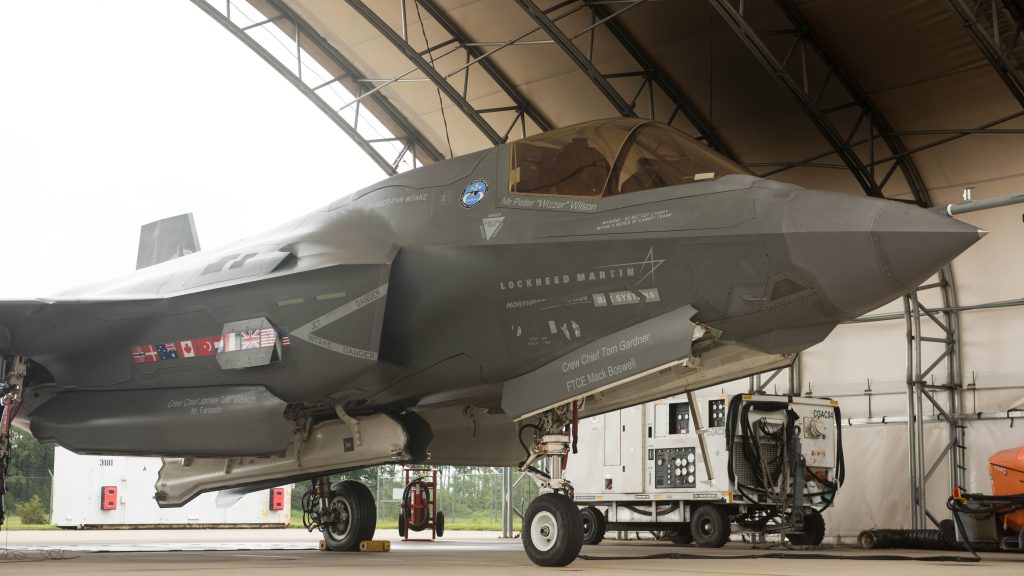
“I still see risk in front of us,” Schmidt said. “We’re not done. We are flying in flight test … almost every day. … I think we’d flown 110 or so TR-3 flights, but you know, we need to get the software stable and to where it needs to be with all of all of the capabilities built into the system, to get it moving forward.”
He would not characterize how the software instability is manifesting, saying only “the software is not as stable as it needs to be and we still have additional capabilities that we need to get some of the deficiencies worked out.”
Asked why the resources to accomplish TR-3 in a timely manner weren’t anticipated, Schmidt said a review last year determined “there was not a good model” for the effort.
“On paper, you can say, ‘I think I need this many humans,’ and those humans cost this many dollars and should take about this much time. The reality is, you don’t always have all the humans that you wish you had,” Schmidt said. “The lab capacity was competing against those other things. … Jets don’t necessarily fly every single day, especially older jets.”
Since then, newer models have been “very telling in terms of our capacity, relative to delivering capability,” he said. Those new models don’t just apply to TR-3, but “we’re now working with a model-based, data-driven discussion on every single capability that we are trying to deliver in this airplane, which is feeding into that that Block 4 contract and what we’re committing to.”
The models for delivering TR-2 were “extremely optimistic,” he said. The resulting delay is now at least “a couple of years from the beginning” but the full delay “all depends on where you start the movie.”
Schmidt would not discuss how the TR-3 situation is affecting contract negotiations for Lots 18 and 19 of the F-35, but he did say there is no urgency to get those negotiations concluded by the end of fiscal 2023 on Sept. 30. There are “an enormous number of things in those conversations,” he added.
A Lockheed spokesperson said the TR-3 “remains our No. 1 development priority” The company is has more than 500 employees, 15 labs, and flight testing at Edwards Air Force Base, Calif., and Naval Air Station Patuxent River, Md., dedicated to the effort.
However, in a statement, Lockheed pointed to the development of the new Integrated Core Processor (ICP) by L3 Harris, a key part of TR-3, as a source of some delays “due to unexpected challenges associated with hardware and software development, component and system integration testing and system qualification testing. The hardware development challenges impacted hardware/software integration, compressing the software testing schedule.”
Lockheed also said it had deployed employees to L3 Harris to help expedite hardware delivery and are also working with Raytheon to speed up delivery of the Next Gen Electro Optical Digital Aperture System (EODAS), another element of TR-3.
An L3Harris spokesperson said the company “overcame some early design challenges and delivered a fully qualifiable Integrated Core Processor (ICP) to Lockheed Martin well over a year ago. In June 2022, L3Harris began delivering flight test hardware after completing Safety of Flight (SOF) qualification testing. We continue to work closely with [Lockheed] to support them in the integration of their software into the TR-3 hardware.”